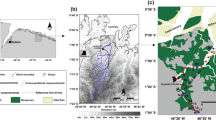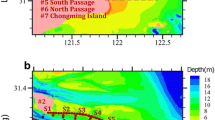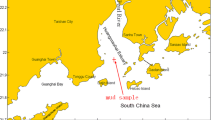Abstract
The Jiaojiang Estuary is a macro-tidal estuary with high turbidity and funnel-shaped geomorphology. Estuarine geomorphology and shipping are highly affected by sediments and heavy coastal engineering. Based on observed data and numerical simulation results, we studied the characteristics of the suspended sediments and fluid mud in the estuary. By considering two-way coupling of water–sediment density and the process of fine sediment flocculation, a three-dimensional sediment model of the Jiaojiang Estuary was established and effectively calibrated using the measured data on tides, currents, and suspended sediment concentration (SSC). Field data analysis indicated that SSC and sediment transport rate in both the main tidal channel and shoals were positively correlated with the flow velocity in the low-frequency part during both the spring and neap tides. The model results revealed that the net sediment flux is controlled by advection and moves landward upstream of the main tidal channel. Fluid mud is formed near Haimen station, with tides influencing the spatial and temporal variations in its thickness and speed. Sediment is actively exchanged among fluid mud-water-seabed, with sink and source processes dominating near the bay mouth and the Haimen station, respectively. Sediments weaken the seaward residual currents slightly by changing their viscosity and the von Karman constant, and the stratification process is affected by changes in water density. The findings of this study provide a foundation for the study of material transportation in an estuarine ecosystem.













Similar content being viewed by others
Data availability
The data that support the findings of this study are available on request from the corresponding authors.
References
Allen JI, Somerfield PJ, Gilbert FJ (2007) Quantifying uncertainty in high–resolution coupled hydrodynamic–ecosystem models. J Marine Syst 64(1–4):3–14. https://doi.org/10.1016/j.jmarsys.2006.02.010
Bi AH, Sun ZL (1984) Preliminary study on the process of Jiaojiang estuary. J Sediment Res 3:14–28. https://doi.org/10.16239/j.cnki.0468-155x.1984.03.002(inChinese)
Bigg PH (2002) Density of water in SI units over the range 0–40°C. Brit J Appl Phys 18(4):521–525. https://doi.org/10.1088/0508-3443/18/4/315
Blake AC, Kineke GC, Milligan TG, Alexander CR (2001) Sediment trapping and transport in the ACE Basin. South Carolina Estuaries 24(5):721–733
Burchard H, Hetland RD, Schulz E, Schuttelaars HM (2011) Drivers of residual estuarine circulation in tidally energetic estuaries: straight and irrotational channels with parabolic cross section. J Phys Oceanogr 41(3):548–570. https://doi.org/10.1175/2010JPO4453.1
Cao ZD, Xiao H (2010) Using hydrological data to predict the evolution trend of seabed erosion and deposition. Port Waterw Eng 2:20–22 (in Chinese). https://doi.org/10.16233/j.cnki.issn1002-4972.2010.02.014
Chen C, Liu H, Beardsley RC (2003) An unstructured grid, finite–volume, three–dimensional, primitive equations ocean model: application to coastal ocean and estuaries. J Atmos Ocean Tech 20(1):159–186. https://doi.org/10.1175/1520-0426(2003)020%3c0159:AUGFVT%3e2.0.CO;2
Corbett DR, Dail M, Mckee B (2007) High–frequency time–series of the dynamic sedimentation processes on the western shelf of the Mississippi River Delta. Cont Shelf Res 26(10–11):1600–1615. https://doi.org/10.1016/j.csr.2007.01.025
Dankers PJT, Winterwerp JC (2007) Hindered settling of mud flocs: theory and validation. Cont Shelf Res 27(14):1893–1907. https://doi.org/10.1016/j.csr.2007.03.005
Dong LX (1998) Classification of highly turbid Jiaojiang Estuary. Acta Oceanol Sin 4:469–482
Dong LX, Wolanski E, Li Y (1997) Field and modeling studies of fine sediment dynamics in the extremely turbid Jiaojiang River estuary. China J Coastal Res 13(4):995–1003
Dyer KR (1986) Coastal and estuarine sediment dynamics. John Wiley & Sons, Chichester, p 358. https://doi.org/10.1002/9781118669280.oth1
Einstein HA, Chien N (1955) Effects of heavy sediment concentration near the bed on velocity and sediment distribution. Omaha, Missouri River Division, Corps of Engineers, US Army, p 78
Fu NP, Bi AH (1989) Discussion on some problems of suspended sediment movement in Jiaojiang. J Sediment Res 3:51–57 (in Chinese). https://doi.org/10.16239/j.cnki.0468-155x.1989.03.007
Geyer WR (1993) The importance of suppression of turbulence by stratification on the estuarine turbidity maximum. Estuaries 16(1):113–125
Geyer WR, Maccready P (2014) The estuarine circulation. Annu Rev Fluid Mech 46(1):175–197. https://doi.org/10.1146/annurev-fluid-010313-141302
Guan WB, Kot SC, Wolanski E (2005) 3–D fluid–mud dynamics in the Jiaojiang Estuary. China Estuar Coast Shelf S 65(4):747–762. https://doi.org/10.1016/j.ecss.2005.05.017
He J, Chu J, Tan SK, Vu TT, Lam KP (2017) Sedimentation behavior of flocculant–treated soil slurry. Mar Georesour Geotec 35:593–602. https://doi.org/10.1080/1064119X.2016.1177625
Holzman B (1943) The influence of stability on evaporation. Ann NY Acad Sci 44(1):13–18. https://doi.org/10.1111/j.1749-6632.1943.tb31289.x
Jeuken MCJL, Wang ZB (2010) Impact of dredging and dumping on the stability of ebb–flood channel systems. Coast Eng 57(6):553–566. https://doi.org/10.1016/j.coastaleng.2009.12.004
Jiang J, Wolanski E (1998) Vertical mixing by internal wave breaking at the lutocline, Jiaojiang River estuary. China J Coastal Res 14(4):1426–1431
Jiang CX (2017) Numerical simulation research on the sediment settling characteristics in the strong tidal current estuarine environment–Take Jiaojiang Estuary of Zhejiang coastal area as an example. M.Sc. Thesis, Zhejiang University, p 94 (in Chinese)
Kerner M (2007) Effect of deepening the Elbe Estuary on sediment regime and water quality. Estuar Coast Shelf S 75(4):492–500. https://doi.org/10.1016/j.ecss.2007.05.033
Li Y, Wolanski E, Xie Q (1993) Coagulation and settling of Suspended sediment in the Jiaojiang River estuary. China J Coastal Res 9(2):390–402
Liu XS, Lu JY, Liao XY, Wu CH (2014) Research status and existing problems of Carmen constant. J Yangtze River Sci Res Inst 31(6):1–6 (in Chinese). https://doi.org/10.3969/j.issn.1001-5485.2014.06.001
Liu W, Fan DD, Tu JB, Lu J (2018) Suspended transportation and flux mechanism of sediment in the Jiaojiang Estuary in spring. Mar Geol Quat Geol 38(1):41–51 (in Chinese). https://doi.org/10.16562/j.cnki.0256-1492.2018.01.005
Liu JB, Ma RB, Yuan YD, Yang XM, Ma WM (2021) Linear stability of a fluid mud–water interface under surface linear long travelling wave based on the Floquet theory. Eur J Mech B-Fluids 86:37–48. https://doi.org/10.1016/j.euromechflu.2020.11.008
Mcanally WH, Friedrichs C, Hamilton D, Hayter E (2007) Management of fluid mud in estuaries, bays, and lakes. I: present state of understanding on character and behavior. J Hydraul Eng 133(1):9–22. https://doi.org/10.1061/(ASCE)0733-9429(2007)133:1(9)
Mellor GL, Yamada T (1982) Development of a turbulent closure model for geophysical fluid problems. Rev Geophys 4(20):851–875. https://doi.org/10.1029/RG020i004p00851
Monge-Ganuzas M, Cearreta A, Evans G (2013) Morphodynamic consequences of dredging and dumping activities along the lower Oka estuary (Urdaibai Biosphere Reserve, southeastern Bay of Biscay, Spain). Ocean Coast Manage 77:40–49. https://doi.org/10.1016/j.ocecoaman.2012.02.006
Ni JR, Hui YJ (1988) Relationship between velocity distribution of muddy water and suspended matter concentration distribution. J Sediment Res 2:19–30 (in Chinese). https://doi.org/10.16239/j.cnki.0468-155x.1988.02.003
Pu X, Shi JZ, Hu GD, Xiong LB (2015) Circulation and mixing along the North Passage in the Changjiang River Estuary, China. J Marine Syst 148:213–235. https://doi.org/10.1016/j.jmarsys.2015.03.009
Qin RY (1991) Study on the variation of Carmen constant of moving bed flow. J Sediment Res 3:38–52 (in Chinese). https://doi.org/10.16239/j.cnki.0468-155x.1991.03.007
Shi JZ, Gu WJ, Wang DZ (2008) Wind wave–forced fine sediment erosion during the slack water periods in Hangzhou bay, China. Environ Geol 55:629–638. https://doi.org/10.1007/s00254-007-1013-2
Shu AP, Fei XJ (2008) Sediment carrying capacity of high sediment–laden flow. Scientia Sinica G 6:653–667 (in Chinese)
Smagorinsky J (1963) General circulation experiments with the primitive equations. Mon Weather Rev 3(91):99–164. https://doi.org/10.1175/1520-0493(1963)0912.3.CO;2
Tran D, Strom K (2019) Floc sizes and resuspension rates from fresh deposits: influences of suspended sediment concentration, turbulence, and deposition time. Estuar Coast Shelf S 229:106397. https://doi.org/10.1016/j.ecss.2019.106397
Uncles RJ, Bloomer NJ (2000) Seasonal variability of salinity, temperature, turbidity and suspended chlorophyll in the Tweed Estuary. Sci Total Environ 251–252:115–124. https://doi.org/10.1016/S0048-9697(00)00405-8
Van Maren DS, Van Kessel T, Cronin K, Sittoni L (2015) The impact of channel deepening and dredging on estuarine sediment concentration. Cont Shelf Res 95:1–14. https://doi.org/10.1016/j.csr.2014.12.010
Wan YY, Dano R, Li WH, Qi DM, Gu FF (2014) Observation and modeling of the storm–induced fluid mud dynamics in a muddy–estuarine navigational channel. Geomorphology 217:23–36. https://doi.org/10.1016/j.geomorph.2014.03.050
Wang SY (1981) Variation of Carmen constant in sediment–laden flow. J Hydr Div–ASCE 107(11):407–417. https://doi.org/10.1061/JYCEAJ.0005645
Wang XH (2002) Tide–induced sediment resuspension and the bottom boundary layer in an idealized estuary with a muddy bed. J Phys Oceanogr 32(11):3113–3131. https://doi.org/10.1175/1520-0485(2002)0322.0.CO;2
Wang ZY, Nestmann F, Larsen P, Dittrich A (1998) Resistance and drag reduction of flows of clay suspensions. J Hydraul Eng 124(1):41–49. https://doi.org/10.1061/(ASCE)0733-9429(1998)124:1(41)
Wang GY (2007) A 2D numerical simulation of suspended sediment in the Taizhou Bay. M.Sc. Thesis, Zhejiang University, p 61 (in Chinese)
Winterwerp JC, Van Kesteren WGM (2006) Introduction to the physics of cohesive sediment in the marine environment. Cambridge University Press
Winterwerp JC, Wang ZB (2013) Man–induced regime shifts in small estuaries–I: theory. Ocean Dynam 63(11):1279–1292. https://doi.org/10.1007/s10236-013-0662-9
Wright LD (1989) Benthic boundary layers of estuarine and coastal environments. Rev Aquat Sci 1:75–95
Xia YZ (2014) The attenuation of shallow–water waves over seabed mud of a stratified viscoelastic model. Coast Eng J 56(4):1450021. https://doi.org/10.1142/S0578563414500211
Xia YZ, Zhu KQ (2011) Fractional–order Maxwell model of seabed mud and its effect on surface–wave damping. Appl Math Mech-Engl 32(11):1357–1366. https://doi.org/10.1007/s10483-011-1506-x
Xie QC, Li BG, Xia XM, Li Y (1998) Vertical distributions of suspended matter and lutoclines in the Jiaojiang Estuary. Acta Oceanol Sin 20(6):58–69 (in Chinese)
Xie M, Wei Z, Guo W (2010) A validation concept for cohesive sediment transport model and application on Lianyungang Harbor. China Coast Eng 57(6):585–596. https://doi.org/10.1016/j.coastaleng.2010.01.003
Xie D, Pan C, Gao S, Wang ZB (2018) Morphodynamics of the Qiantang Estuary, China: controls of river flood events and tidal bores. Mar Geol 406:27–33. https://doi.org/10.1016/j.margeo.2018.09.003
Xu XS, Zhang XZ, Li Q, Xia WY, Zhao XD (2018) Water and sediment characteristics and maximum turbidity simulation of Jiaojiang River. Port Waterw Eng 12:143–151 (in Chinese). https://doi.org/10.16233/j.cnki.issn1002-4972.20181130.004
Xu CY, Chen YP, Pan Y, Yu LL (2020) The effects of flocculation on the entrainment of fluid mud layer. Estuar Coast Shelf S 240:106784. https://doi.org/10.1016/j.ecss.2020.106784
Yang XC, Zhang QH, Hao LN (2015) Numerical investigation of fluid mud motion using a three–dimensional hydrodynamic and two–dimensional fluid mud coupling model. Ocean Dynam 65(3):449–461. https://doi.org/10.1007/s10236-015-0815-0
Yang XC (2014) Numerical simulation of fluid mud formation and movement on muddy coast. M.Sc. Thesis, Tianjin University, p 150 (in Chinese)
Zhang HW (1995) The formula of vertical distribution of sediment–laden flow velocity. J Sediment Res 2:1–10 (in Chinese). https://doi.org/10.16239/j.cnki.0468-155x.1995.02.001
Zhao LB (1992) The effect of salt–freshwater mixing in Jiaojiang Estuary. Mar Sci 1:61–64 (in Chinese)
Zhao GB, Bian CW, Xu JP (2019) A field study of shear stress and suspended sediment concentration in the bottom boundary layer under the influences of tidal currents and wind waves. Period Ocean Univ China 49(11):83–91 (in Chinese). https://doi.org/10.16441/j.cnki.hdxb.20180413
Zheng YQ (2021) Study on hydrodynamics and sediment transport characteristics in the Jiaojiang Estuary. M.Sc. Thesis, Zhejiang University, p 126 (in Chinese)
Zhou YL, Tang HW, Yan J, Xu ZG, Guo Q (2008) The influencing factors of Carmen constant of sediment carrying flow. J Sediment Res 3:51–56 (in Chinese). https://doi.org/10.16239/j.cnki.0468-155x.2008.03.007
Acknowledgements
This research was supported by the National Key Research and Development Program of China (2020YFD0900803), the National Natural Science Foundation of China (41976157, 42076177), and the Zhejiang Provincial Natural Science Foundation of China (2020C03012, 2022C03044, U1709204).
Author information
Authors and Affiliations
Corresponding authors
Additional information
Publisher's Note
Springer Nature remains neutral with regard to jurisdictional claims in published maps and institutional affiliations.
Rights and permissions
Springer Nature or its licensor (e.g. a society or other partner) holds exclusive rights to this article under a publishing agreement with the author(s) or other rightsholder(s); author self-archiving of the accepted manuscript version of this article is solely governed by the terms of such publishing agreement and applicable law.
About this article
Cite this article
Li, L., Wang, J., Zheng, Y. et al. Fluid Mud Dynamics and Its Correlation to Hydrodynamics in Jiaojiang River Estuary, China. Ocean Sci. J. 58, 8 (2023). https://doi.org/10.1007/s12601-023-00102-5
Received:
Revised:
Accepted:
Published:
DOI: https://doi.org/10.1007/s12601-023-00102-5




